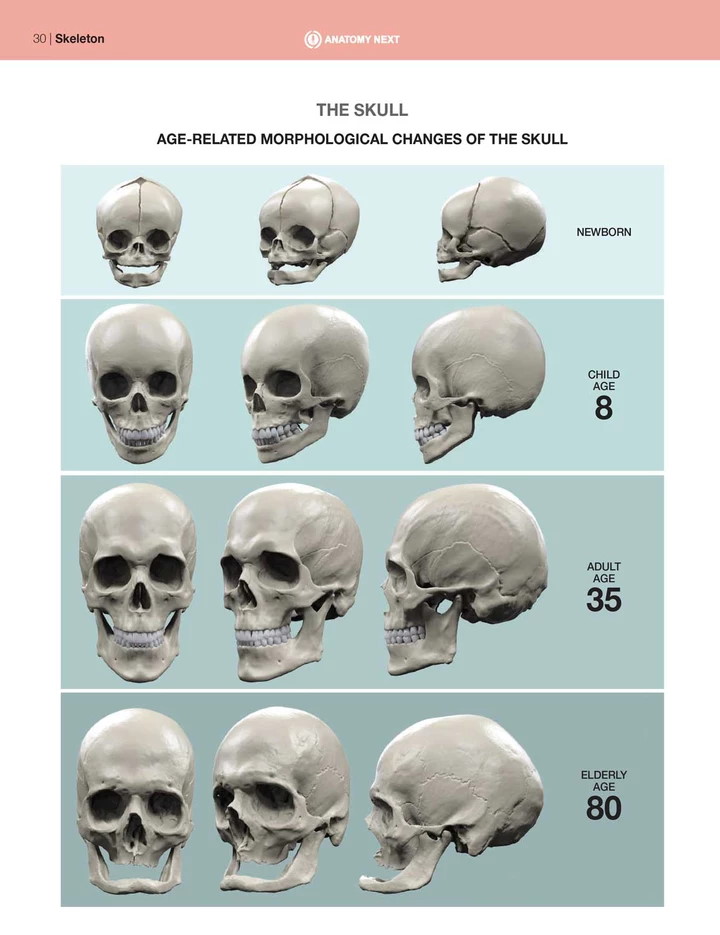Georgeous
Iron
- Joined
- Aug 19, 2024
- Posts
- 63
- Reputation
- 50
What could an ideal unit of measurement for Human Facial Features? The Facial Features largely vary with gender, age, genetic and climate. A careful observation of human skull can give the following insights.
 Age related changes on human skull. Image Courtesy . All images used for this study is from external source and the image courtesy is duly linked to the original site.
Age related changes on human skull. Image Courtesy . All images used for this study is from external source and the image courtesy is duly linked to the original site.
Even though Interocular distance is a good candidate, is there any possibility of large variation of its measurements over gender, age, genetic and climate? The interocular distance can be further break down into ‘outer canthal distance’ , ‘interpupillary distance’ and ‘inner canthal distance’
 Inner Canthal Distance Image Courtesy. All images used for this study is from external source and the image courtesy is duly linked to the original site.
Inner Canthal Distance Image Courtesy. All images used for this study is from external source and the image courtesy is duly linked to the original site.
The below figure shows that, inter canthal distance is one feature which has less change over the years of age progression.
 Canthal Distance progression over age. Image Courtesy. All images used for this study is from external source and the image courtesy is duly linked to the original site.
Canthal Distance progression over age. Image Courtesy. All images used for this study is from external source and the image courtesy is duly linked to the original site.
The InterPupillary Distance is one feature that has no significant difference between males and females. The average InterPupillary Distance for males and females across different ethnicity is around 64mm.
IPD = InterPupillary Distance/64 is the standard used for measuring facial features from an image at PinkMirror Facial Aesthetics Studio.
The IPD is also subjected to photographic distortions. https://www.researchgate.net/public...tography_Further_Reasons_Why_Turner_Was_Wrong. Hence the selection of photographic equipment needed to be carefully considered.
 Eye Orbital Features. Image Courtesy. All images used for this study is from external source and the image courtesy is duly linked to the original site.
Eye Orbital Features. Image Courtesy. All images used for this study is from external source and the image courtesy is duly linked to the original site.
Distinctive face features of a child with Fetal Alcohol Syndromewho have brain damage and resulted low intelligence.
 Facial Features with FAS. Image Courtesy. All images used for this study is from external source and the image courtesy is duly linked to the original site.
Facial Features with FAS. Image Courtesy. All images used for this study is from external source and the image courtesy is duly linked to the original site.
 Facial Features to identify FAS. Image Courtesy. All images used for this study is from external source and the image courtesy is duly linked to the original site.
Facial Features to identify FAS. Image Courtesy. All images used for this study is from external source and the image courtesy is duly linked to the original site.
The genetical deformity of orbital area can be further studied in the below link.
https://onlinelibrary.wiley.com/doi/10.1002/ajmg.a.32597
- The least changed shape in human skull is eye socket (anatomically known as ‘Orbit’).
- The least changed dimension is the interocular distance.
- Jaw is in its peak shape during the most reproductive age. This is also the most changing shape on face.
- The face-width has less variation over age, in comparison to face-height.

Even though Interocular distance is a good candidate, is there any possibility of large variation of its measurements over gender, age, genetic and climate? The interocular distance can be further break down into ‘outer canthal distance’ , ‘interpupillary distance’ and ‘inner canthal distance’

The below figure shows that, inter canthal distance is one feature which has less change over the years of age progression.

The InterPupillary Distance is one feature that has no significant difference between males and females. The average InterPupillary Distance for males and females across different ethnicity is around 64mm.
IPD = InterPupillary Distance/64 is the standard used for measuring facial features from an image at PinkMirror Facial Aesthetics Studio.
The IPD is also subjected to photographic distortions. https://www.researchgate.net/public...tography_Further_Reasons_Why_Turner_Was_Wrong. Hence the selection of photographic equipment needed to be carefully considered.
Abnormal Inter Canthal Distances
For a well formed facial structure, the inter canthal distance is correlated with width of eye. If there is an imbalance in inter canthal distance, it can cause ‘Telecanthus’ or ‘Orbital hypertelorism’
Distinctive face features of a child with Fetal Alcohol Syndromewho have brain damage and resulted low intelligence.


The genetical deformity of orbital area can be further studied in the below link.
https://onlinelibrary.wiley.com/doi/10.1002/ajmg.a.32597


